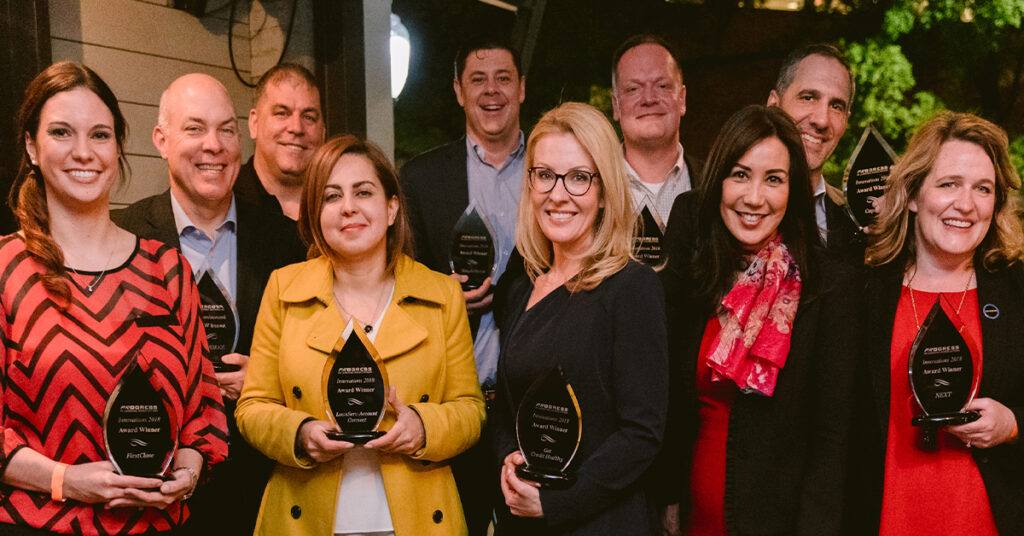Discussing True Innovation
The PROGRESS in Lending Innovations Award Winners gathered to talk about the future of mortgage lending. Over 100 mortgage executives came together to attend PROGRESS in Lending Association’s Ninth Annual Innovations Awards Event. We named the top innovations of the past twelve months. After that event, we wondered what would happen if we brought together executives from the winning companies to talk about mortgage technology innovation. Where do they see the state of industry innovation right now? And what innovation is it going to take to get our industry really going strong? To get these and other questions answered, we got the winning group together. In the end, here’s what they said:
Q: Some say innovation has to be sweeping change. Others say innovation can be incremental change. How would you define innovation?
JERI YOSHIDA: Innovation is filling an unmet need with a solution that people prefer over their previous options. I don’t think that sweeping versus incremental change is a major factor in determining innovation.
STEVE VIARENGO: We define innovation as the transformation of the way a company or a process works. Disruptive, sweeping change is exciting, but unless you’re a start up, it’s rarely practical. Most companies need to protect their core business while driving change, so incremental change is necessary for success. At Capsilon, we provide disruptive technology that fundamentally changes how companies work. Over the years, we’ve learned how to implement innovative new processes in incremental ways that help companies realize an immediate, positive business impact while marching toward broader, more sweeping changes that add up over time.
SARA NAKAE: You can’t put innovation in a box or on a timeline, innovation happens through thought, focus, and excellence. Innovation can be either sweeping or incremental, it’s not an all or nothing process. In fact, the definition of innovation does not contemplate “how” a new product or service is introduced, innovation is taking a great idea and turning it into a valued product or service that customers will buy. From a business standpoint, incremental innovation is the more popular approach because it comes with less financial risk to the organization. But sweeping, or radical, innovation is something that shouldn’t be ignored either. Both exist and both have their merits. But the key to innovation is to focus on the impact to the customer, did you improve their user experience? Innovation can happen incrementally or sweeping, as long as the product or service creates value from the customer’s perspective.
MATT HANSEN: I like to think of innovation as something that changes the status quo. It can be organizing and making sense of other’s ideas. Innovation can also be something that is more self-created. Either way, I believe innovation requires execution.
SHAIMAA ELK: Innovation comes in all forms and should not be limited to being seen as a sweeping change. Innovation can be defined as simply as the application of ideas to remain relevant.
BOB BRANDT: To Optimal Blue, innovation is not a tsunami that happens, and everyone then reacts to that moment in time. Innovation is not something you revisit only when you have the time. At Optimal Blue, innovation is a pillar in our corporate DNA. We view innovation as a constant, as something that drives our approach each and every day.
ELIZABETH KARWOWSKI: Save once in a generation discoveries, I don’t think sweeping change is possible without being preceded by smaller, incremental changes. In other words, small changes to procedures or products over a period of months or years often have the effect of completely transforming them into something that’s never been done or seen before. It’s often not until we look back to where we started that we fully grasp the gravity of those seemingly small changes made along the way.
DAVE SIMS: I would define innovation as anything that has the potential to dramatically change a market. In terms of the mortgage industry – an industry where processes have mostly remained unchanged for more than 80 years – the introduction of digital automation and point-of-sale solutions have caused massive disruptions by simplifying the once-complex and non-secure process of originating a mortgage loan, thus setting a new standard in borrower expectations. Floify was one of the first of its kind to market in 2013. Since then, we have seen our user base grow to nearly 700,000 lenders, borrowers, and other loan stakeholders. Every day, more and more lending operations are transitioning to digital solutions, which is helping them remain competitive in this highly-competitive industry and allowing them to effectively fight margin compression. To me, the recent changes in the mortgage industry have been the epitome of innovation.
BOB DOUGHERTY: Innovation can be incremental or sweeping, depending on your business objectives and strategy. Both sweeping and incremental innovation promise great benefits—improved accuracy, speed and profits. However, incremental innovation lacks many of the challenges that come with radical change, such as significant disruption of day-to-day business or heavy time and resource investments in new technology that may or may not work.
Q: How would you define the state of innovation in the mortgage industry? Is it thriving or in a state of decay?
SHAIMAA ELK: The state of innovation in the mortgage industry is modest at the moment. If innovation is the application of ideas to remain relevant than a key element in the equation is the degree of underlying change in regulations, processes and expectations that drive that relevance equation. The mortgage industry is currently heavily regulated, which impacts its speed of change. In this current environment, industry change is still slow and limited, which has put a reduced demand on the need for innovation.
MATT HANSEN: Organization of ideas is happening in the mortgage space. There’s rarely a new idea, but execution of ideas is getting a lot more attention. Some companies are able to execute, and some are not. We’re also seeing vendors open the doors between each other, which previously didn’t happen on the same scale. This is bringing new products to the market. For this reason, I would say we are in a state of growth and innovation.
STEVE VIARENGO: It is an exciting time to be in the mortgage industry. There has been a significant influx of capital invested in technologies that enable a better way of doing business, legacy technology companies are recognizing the need to create more open environments and work with other tech providers, and companies in the space are embracing change. We’ve been working closely in partnership with our lender, investor, and servicing partners to build innovative solutions that solve the biggest pain points for companies in the space.
BOB BRANDT: We are in the midst of an innovation renaissance period in the mortgage industry. There are more technology vendors developing more interesting approaches to automation and problem-solving than ever before. Optimal Blue believes that the state of innovation is thriving! However, the challenge that industry innovators face is to think beyond technology silos. For this very reason, Optimal Blue has developed robust and highly unique RESTful API interfaces that +50 leading mortgage vendor partners leverage to break down the integration barriers between mortgage technology systems that have historically held back the industry.
SARA NAKAE: With today’s economy and the advances in technology and data availability, innovation in the mortgage industry is moving from stagnant to thriving. There’s been a lot new capital infusion through various FinTech companies over the past 24 months. Financial institutions are becoming more competitive every day, each one trying to produce a better product and borrowing experience. Reducing costs and turn-time are big factors for lenders who want to compete, and they are putting their focus on innovative ways to improve their product and their process.
BOB DOUGHERTY: Innovation is thriving in the mortgage industry. Technology providers are constantly launching new solutions; enhancing their existing products; and integrating with other technology providers to streamline and accelerate the mortgage origination process for everyone involved. From a broker perspective, all of this technology is empowering because it lets them focus more on their borrowers and less on manual processes or maintaining software or hardware.
DAVE SIMS: I believe the state of innovation in the current mortgage industry is neither thriving nor in a state of decay; rather, it is now in a mode of stabilization. When Floify’s automation technology was introduced to lenders in 2013, there were only a few players in the space, all vying for a piece of the mortgage tech market. Since then, dozens of hopeful competitors have come and gone. Only a few have withstood the test of time. What has set Floify apart from our competition is our ability to continue our pace of innovation and partnering with like-minded leaders in complementary spaces, including VOE/VOA/VOI, credit reporting, eSignature, and productivity vendors. This strategy has allowed us to develop a single solution that integrates with our customers’ favorite solutions, further simplifying their lending operations.
JERI YOSHIDA: I wouldn’t call innovation in our space thriving, but the work I do with NEXT has shown me that there are a lot of new technologies entering the mortgage industry. How many of them are truly innovative? That’s the question. A lot of companies want to be the one that takes the mortgage industry out of its old school, manual, paper-based processes. And a lot of them are working really hard to stake that claim by conceptualizing new technologies and bringing them to market. That in itself refutes the notion that our industry is in a state of decay.
ELIZABETH KARWOWSKI: The mortgage industry is fiercely competitive, and competition almost always breeds innovation. There is no better teacher than past experience and, as mortgage professionals learn from past missteps and accomplishments, we are seeing new ways in which technology is leveraged to increase efficiency and streamline processes. In this industry it is almost impossible to be successful without constantly tweaking and tinkering to get an edge on the competition.
Q: Lastly, if there was one innovation that you would say the mortgage industry desperately needs to happen over the next twelve months, what would it be?
SARA NAKAE: Focus on their customer, how can lenders create a better experience for their borrower? It’s a combination of cost and time. Lenders need to focus on reducing the cost for customer’s to get a loan and the time it takes to close. Innovation that focuses on those deliverables will be winning over the next 12 months.
SHAIMAA ELK: The industry could use a fresh approach to mortgages, a re-imagining of the entire process. This would require a joint effort with lenders, investors, regulators and vendors. But in the meantime, the more pressing issue is not what type of innovation the industry needs, but how quickly can we adopt the innovation that is readily available today, like digital portals, robotic process automation (RPA), data analytics, and blockchain. Furthermore, beyond adoption, there’s the notion of packaged solutions that deliver integrated solutions from “best-of-breed” providers. This is a different perspective on innovation that could prove to be equally as fruitful.
BOB BRANDT: As an industry, we are beyond the desperate need for “the ONE innovation” that we hope will make the key difference. We believe that the industry is at a point where the most significant difference will be made by a series of incremental innovations by a host of companies. Optimal Blue has already automated the secondary marketing process, and now our focus has turned toward a series of even more granular functionalities and automation that will pave the road for an entirely new way of conducting originations in the industry. A good example of that is our “lights-out” lock desk and trading platform automations.
BOB DOUGHERTY: Since origination volume is expected to remain flat this year, more brokers and lenders are turning to non-agency/non-QM products to reach underserved borrowers. Originating these loans is typically a manual process. In order for the non-agency/non-QM market to scale, the mortgage industry needs technology that allows originators to quickly and confidently qualify these borrowers.
STEVE VIARENGO: The absence of good data is one of the most significant barriers to innovation in the mortgage industry. Having clean, accurate information you can trust is a critical element needed for automation, risk reduction, and cost reduction. Companies can now solve this problem with technology like Capsilon¹s doc and data audit tools that enable them to build a complete, accurate record for every loan. Companies who don¹t adopt these types of technologies over the next twelve months are going to find it hard to take advantage of a wave of innovative technologies coming that require clean data to be effective. The massive impact these technologies will have on the mortgage industry is now undeniable. Companies who lag will be left behind.
MATT HANSEN: Twelve months is a very short period of time. It seems most likely this idea has already been conceived and mostly built if it’s to come to market in the next 12 months. That being said, the cost of human capital has been difficult for lenders in lean times. In order to solve this, it would need to be an innovation that cuts into the biggest expenses lenders incur on a per loan basis.
ELIZABETH KARWOWSKI: I think it’s time to turn our attention to potential borrowers who don’t fall within traditional lending parameters. Specifically, Millennials and younger generations are entering the work force with priorities and values that often differ greatly from Baby Boomers and Generation X. Many of them have never had a credit card, and don’t have any credit history or credit profile at all. It is imperative that the industry begins implementing educational programs and providing resources in order to ensure that these young people, (who will eventually make up the majority of the population) see the value in home ownership and will actually qualify for a mortgage.
DAVE SIMS: The mortgage industry would greatly benefit from an innovation that improves the accuracy of real estate appraisals. In fact, more than one in three appraisals contain inconsistencies in property ratings and values. Additionally, conflicting property condition and quality ratings can result from numerous factors, including human error, appraiser subjectivity, physical changes in property condition or quality, or even possible fraud, which has been cited by the GSEs as the top origination fraud scheme trend in recent years. Developing an innovation that would create consistencies across the appraiser network would be the perfect way to combat this troubling trend.
JERI YOSHIDA: The mortgage industry desperately needs innovative change in the way it thinks and interacts as an industry. There is no shortage of sharp minds and great ideas, but in order to fully capitalize on them, the industry needs a shift in its thinking. Day in and day out, I work with more brilliant executives through NEXT than I have at any other time during my decades-long career in this industry. If these particular executives were leveraged in C-suite positions, or if they were given a more visible platform, I suspect we’d see the start of a massive push forward—in innovation, creative ideas, opportunity, and so much more. This would in turn produce other measurable results from higher client and employee satisfaction to higher recruitment of top talent. This could set the tone for not one or two innovations, but rather a culture of innovation that yields a decade or more of brilliant, truly innovative advances in the mortgage industry.

The Place for Lending Visionaries and Thought Leaders. We take you beyond the latest news and trends to help you grow your lending business.



